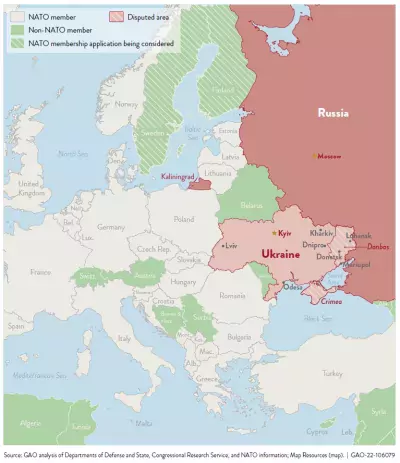As the U.S. Continues Its Support of Ukraine, Here Are Some Considerations
Russia’s invasion of Ukraine in February sparked the largest European war since World War II. The response of the United States and its partners has been swift and continuing. This support includes billions of dollars in emergency military and humanitarian assistance to Ukraine.
We have a large body of work analyzing how the U.S. generally provides democracy assistance and humanitarian aid, as well as military technology and military presence.
Today’s WatchBlog post looks at our new snapshot summarizing this body of work and putting it into the context of how it could inform the U.S. efforts in Ukraine.
Image

Democracy assistance and humanitarian aid
Congress approves funds each year to be used to bolster democracy abroad as a way to promote American values, national security, and economic opportunity. This has included work aimed at strengthening human rights, independent media, and the rule of law.
The State Department and the U.S. Agency for International Development (USAID) lead and coordinate these efforts. However, we’ve found ways to improve this coordination. For example, State could do a better job sharing information on its democracy assistance projects internally. This would help State coordinate internally and with other agencies to achieve its goals.
State and USAID also partner with non-governmental organizations to deliver humanitarian assistance around the world, often in unstable or high-conflict areas like Ukraine. These partnerships allow U.S. assistance to reach the neediest communities. But, we found that providing aid in these unstable or high-conflict areas also comes with the risk of fraud and other financial crimes. We also found that security concerns can make it more difficult for U.S. officials to check for fraud in these humanitarian assistance programs.
Military technology and presence
In response to Russia's annexation of Crimea in March 2014, then-President Obama announced the European Reassurance Initiative (now the European Deterrence Initiative), to reassure allies in Europe of U.S. commitment to their security.
Since 2014, the Department of Defense (DOD) has expanded the initiative's objectives, increased its funding, and enhanced the U.S. military presence in Eastern Europe. DOD expanded its objectives to include deterring Russian aggression in the long term and developing the capacity to field a combined force should deterrence fail, but that all comes at a financial cost to the United States.
Further, should deterrence fail, the U.S. risks losing control of the battlefield if it doesn't control the electromagnetic spectrum, according to DOD. This spectrum is critical for communications, navigation, weapons, and more. Russia poses a threat to U.S. control of the electromagnetic spectrum. Its electromagnetic warfare forces have been described by the Defense Intelligence Agency as "world class," and have demonstrated effectiveness in real-world applications against U.S. and foreign militaries.
In our work, we found that earlier strategies to help DOD improve its spectrum capabilities have fallen short. We’ve recommended that DOD identify its procedures and processes necessary to provide for an integrated defense-wide strategy, planning, and budgeting for its joint electromagnetic spectrum operations and its long-term sustainment and infrastructure costs in Europe.
Without better strategy, planning, and budgeting for electromagnetic reforms and for identifying U.S. military sustainment and infrastructure costs in Europe, DOD’s goals of battlefield superiority could be at risk.
Why it matters
The war in Ukraine raises national security concerns for the United States and its European allies.
Successful assistance to Ukraine and deterrence of Russia from further aggression—in Ukraine and elsewhere—will depend on continued efforts by DOD and the intelligence community. It will also depend on efforts by State and USAID to provide humanitarian assistance to Ukraine and its neighboring countries.
U.S. federal agencies must act in a timely manner going forward, and congressional oversight of ongoing efforts will be vital to help ensure accountability.
Check out our new snapshot to find out more about considerations for the U.S. efforts in Ukraine.
- Comments on GAO’s WatchBlog? Contact blog@gao.gov.
GAO Contacts
Related Products

GAO's mission is to provide Congress with fact-based, nonpartisan information that can help improve federal government performance and ensure accountability for the benefit of the American people. GAO launched its WatchBlog in January, 2014, as part of its continuing effort to reach its audiences—Congress and the American people—where they are currently looking for information.
The blog format allows GAO to provide a little more context about its work than it can offer on its other social media platforms. Posts will tie GAO work to current events and the news; show how GAO’s work is affecting agencies or legislation; highlight reports, testimonies, and issue areas where GAO does work; and provide information about GAO itself, among other things.
Please send any feedback on GAO's WatchBlog to blog@gao.gov.




